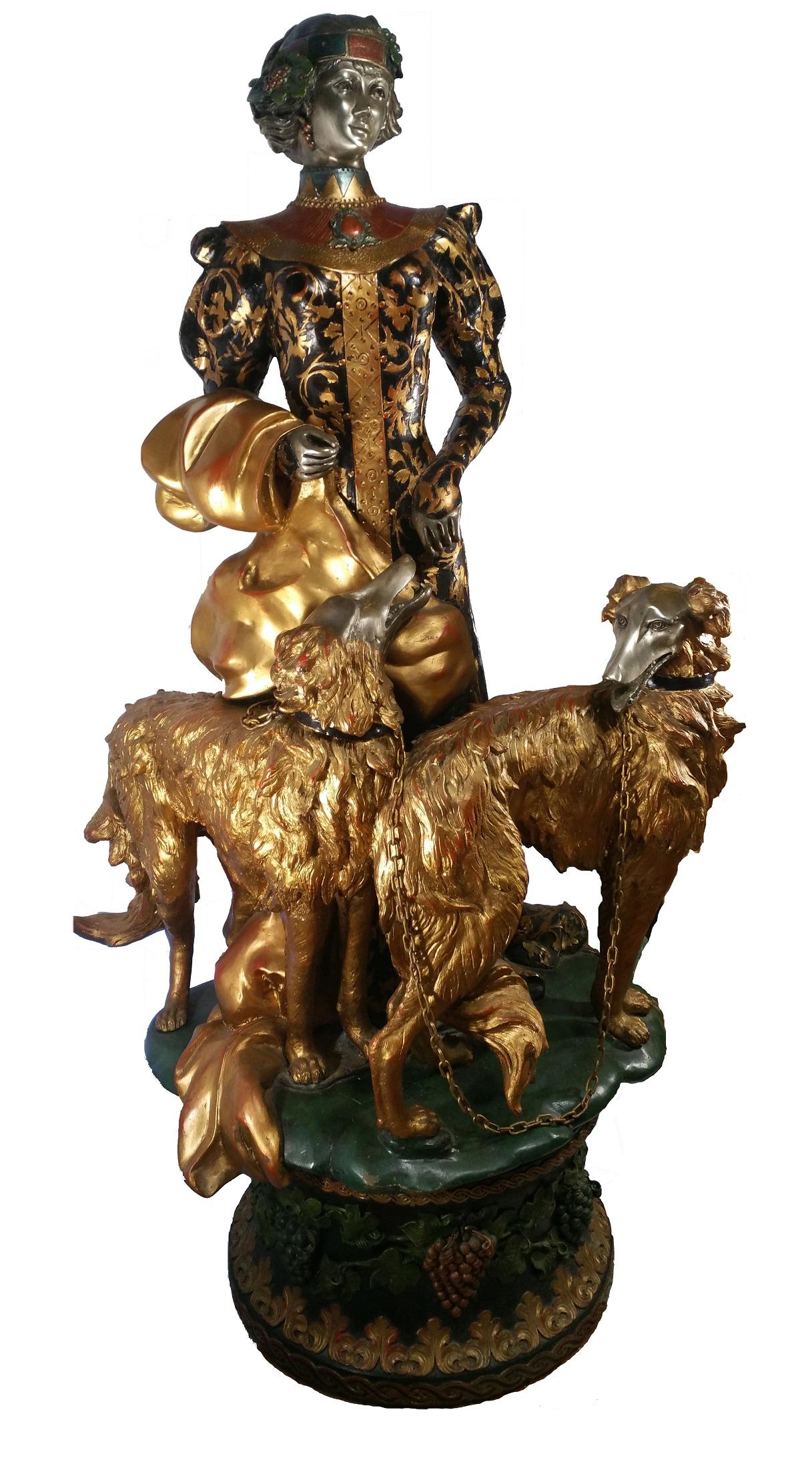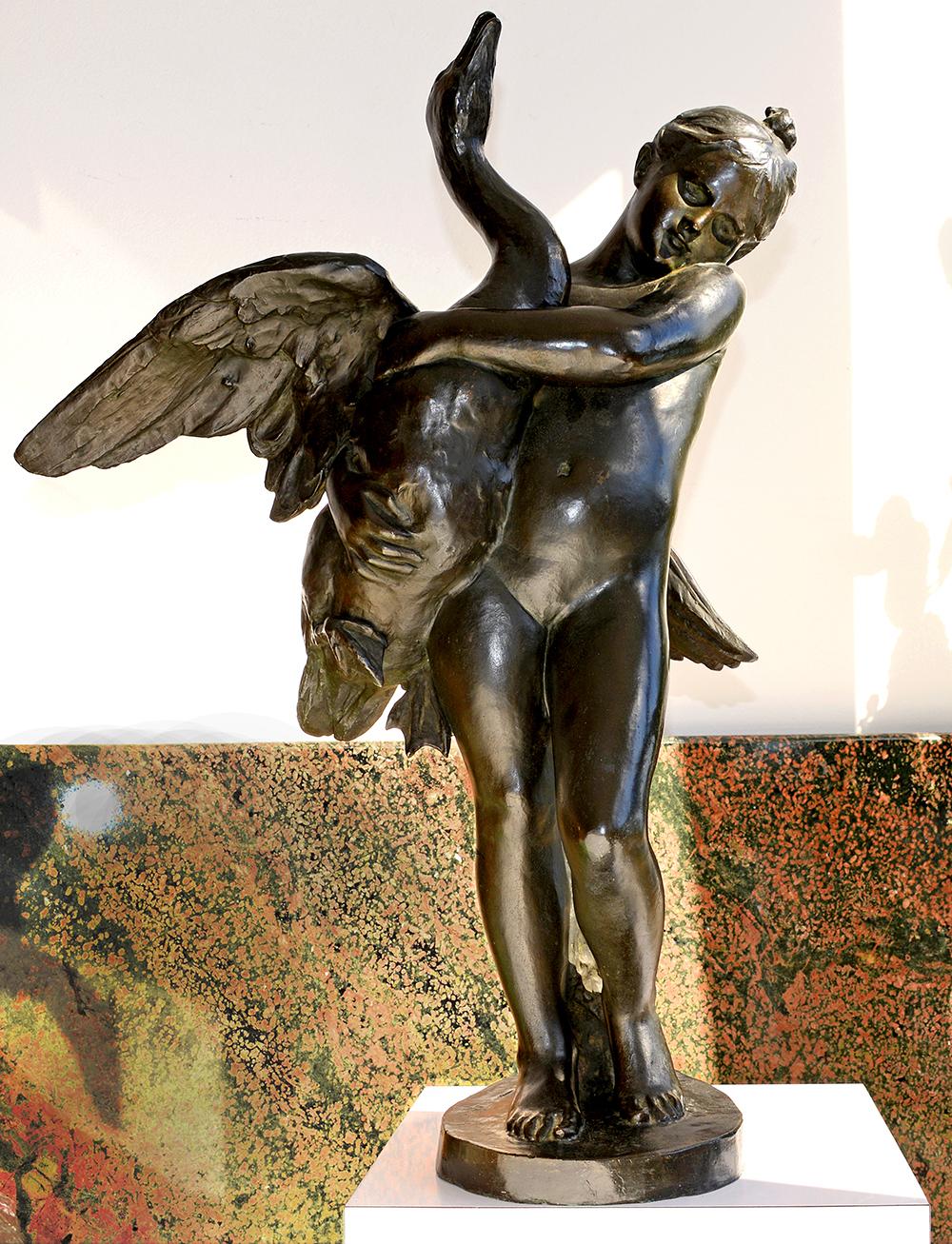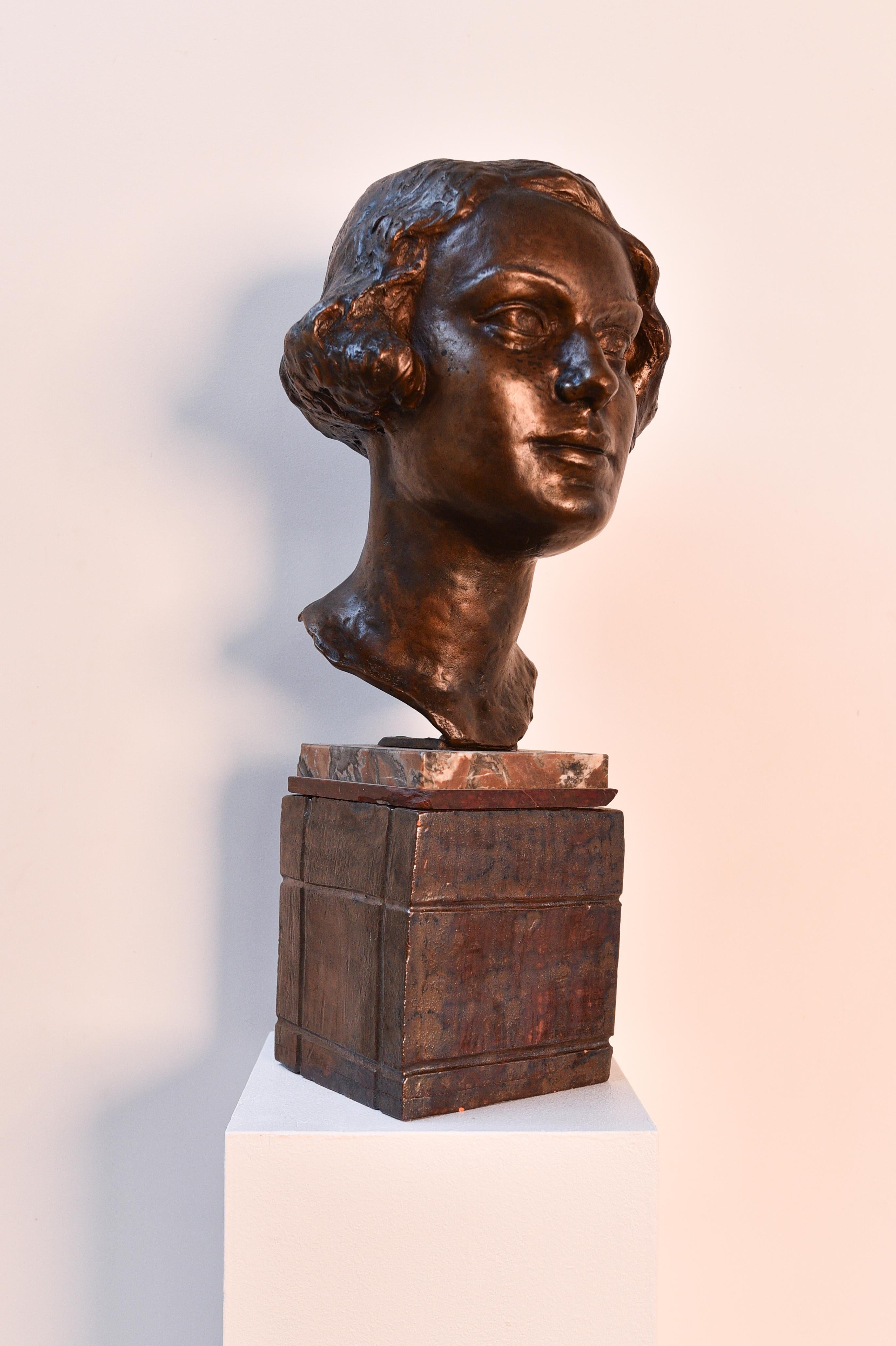Items Similar to La Cothurne
Want more images or videos?
Request additional images or videos from the seller
1 of 9
Agathon LéonardLa Cothurne1901
1901
About the Item
"La Cothurne" 1901
Gilt Bronze
Approx 21.5" High (to raised hand)
Signed and Dated
Foundry Mark "Susse Freres"
Originally modeled in white biscuit porcelain this Greek dancer is a from a set of eight created for a dining table. They were immediately successful when they were exhibited in the Sevres pavilion at the 1900 Exhibition. Individual figures could be ordered and "La Cothurne" proved the most popular. Their success led to the firm of Susse buying the right to cast versions in metal.
Agathon Leonard (1841-1923) is one of the well-known French Art Nouveau sculptors. Born in Lille in 1841, he first studied there before moving to Paris where he studied at the Ecole des Beaux Arts under Eugene Delaplanche.
He gained recognition at the annual Expositiones Universelles, winning a Silver Medal there in 1889 and gold in 1900. His most important piece, Jeu L'echarpe, was the best known series of Sevres production at the turn of the century and sold out at the 1900 Expo in Paris and later was given as a gift by the French Gov't to Nicholas II at the Hermitage.
His bronzes were cast at the Susse Freres Editeurs Foundry. He worked also in marble, quartz and ivory. He also produced Art Nouveau medallions, statuettes and pottery.
His work is held at the Victoria & Albert Museum, the Art Institute of Chicago, and Abbeville and Nantes Museums.
He became a member of the Societe des Artistes Francois in 1887 and the Society Nationale des Beaux-Arts in 1897. He was made a chevalier of the Legion d'Honneur in 1900.
- Creator:Agathon Léonard (1841 - 1923, French)
- Creation Year:1901
- Dimensions:Height: 21.5 in (54.61 cm)Width: 6 in (15.24 cm)
- Medium:
- Movement & Style:
- Period:
- Condition:
- Gallery Location:Missouri, MO
- Reference Number:1stDibs: LU74732666973
About the Seller
5.0
Vetted Seller
These experienced sellers undergo a comprehensive evaluation by our team of in-house experts.
Established in 1970
1stDibs seller since 2017
141 sales on 1stDibs
Typical response time: 23 hours
- ShippingRetrieving quote...Ships From: Missouri, MO
- Return PolicyA return for this item may be initiated within 2 days of delivery.
More From This SellerView All
- Study AimBy Carl KaubaLocated in Missouri, MOCarl Kauba "Study Aim" c. 1920 Bronze with Brown Patina Signed approx. 9.5 x 10 x 4 This Austrian sculptor was born in Vienna in 1865. His teachers were Karl Waschmann (1848-1905), known for his ivory sculptures and portrait plaquettes of contemporary celebrities, and Stefan Schwartz (1851-1924), who exhibited in Paris, including the Exposition Universelle of 1900 where he won a gold medal. Kauba's intricate bronzes, imported to the United States between 1895 and 1912, were cast at the Roman Bronze Works. Kauba was part of the nineteenth-century tradition of polychrome bronze sculpture. There were several types of patinas on a single statue: he could render the color of buckskin, variously tinted shirts, blankets, feathers, as well as beaded moccasins. Reportedly, Kauba came to America around 1886. Inspired by the Western tales of German author Karl May, he traveled to the West and made sketches and models. Critics, however, pointed out inaccuracies of costume and other details. For instance, the guns that his "mid-nineteenth-century" figures use are models produced after 1898. Apparently he did all of his works back in Vienna. Besides the variety of color, Kauba's bronzes show a great range of textures and his style is highly naturalistic. The sculptor loved ornament, some of which he rendered with coiled wire for reins, rope and feathers in headdresses. He successfully rendered figures in motion and often executed compositions with more than one figure. Berman (1974) illustrates non-Western subjects by Kaula, such as the pendants Where? and There (ca. 1910), a seated Scottish couple, impressive in the expressions and the details on patterned fabrics of both sitters. Another genre piece is Buster Brown...Category
Early 20th Century Realist Figurative Sculptures
MaterialsBronze
- Going into BattleBy Carl KaubaLocated in Missouri, MOCarl Kauba "Going into Battle" c. 1920s Bronze with Brown Patina Signed approx 10 x 10 x 4 (including wooden base) This Austrian sculptor was born in Vienna in 1865. His teachers were Karl Waschmann (1848-1905), known for his ivory sculptures and portrait plaquettes of contemporary celebrities, and Stefan Schwartz (1851-1924), who exhibited in Paris, including the Exposition Universelle of 1900 where he won a gold medal. Kauba's intricate bronzes, imported to the United States between 1895 and 1912, were cast at the Roman Bronze Works. Kauba was part of the nineteenth-century tradition of polychrome bronze sculpture. There were several types of patinas on a single statue: he could render the color of buckskin, variously tinted shirts, blankets, feathers, as well as beaded moccasins. Reportedly, Kauba came to America around 1886. Inspired by the Western tales of German author Karl May, he traveled to the West and made sketches and models. Critics, however, pointed out inaccuracies of costume and other details. For instance, the guns that his "mid-nineteenth-century" figures use are models produced after 1898. Apparently he did all of his works back in Vienna. Besides the variety of color, Kauba's bronzes show a great range of textures and his style is highly naturalistic. The sculptor loved ornament, some of which he rendered with coiled wire for reins, rope and feathers in headdresses. He successfully rendered figures in motion and often executed compositions with more than one figure. Berman (1974) illustrates non-Western subjects by Kaula, such as the pendants Where? and There (ca. 1910), a seated Scottish couple, impressive in the expressions and the details on patterned fabrics of both sitters. Another genre piece is Buster Brown...Category
Early 20th Century Realist Figurative Sculptures
MaterialsBronze
- Mountain GoatBy Jules MoigniezLocated in Missouri, MOJules Moigniez "Mountain Goat" Bronze approx 11 x 9 x 4 inches Signed Jules Moigniez (1835-1894) Jules Moigniez was born in Senlis sur L'Oise, France ...Category
1870s Realist Figurative Sculptures
MaterialsBronze
- Chien Braque (Tom)By Pierre Jules MêneLocated in Missouri, MOPierre Jules Mene "Chien Braque" (Tom) Bronze approx. 5 x 9 x 4.25 Signed PIERRE JULES MENE (1810-1879) Pierre Jules Mene, (P. J. Mene), was born in Pa...Category
1860s Realist Figurative Sculptures
MaterialsBronze
- The Hunter and HoundBy Pierre Jules MêneLocated in Missouri, MOPierre-Jules Mene "The Hunter and Hound" (Le Valet de Limier) 1879 Bronze approx. 19 x 8 x 14 inches Signed PIERRE JULES MENE (1810-1879) Pierre...Category
1870s Realist Figurative Sculptures
MaterialsBronze
- Little Red Riding Hood InkwellBy Antoine BofillLocated in Missouri, MOAntoine Bofill "Little Red Riding Hood" Bronze Inkwell 6H x 10W x 6D Signed Inscribed: 25 Septembre 1920 Antoine Bofill was born in Barcelona i...Category
1920s Realist Figurative Sculptures
MaterialsBronze
You May Also Like
- Woman with Two Borzoi DogsLocated in Saratoga Springs, NYMonumental, Art Nouveau, Bronze Sculpture – Anonymous (20th Century) “Woman with Two Borzoi Dogs” 6 feet 7 inches high x 3 feet 3 inches wide x 2 feet 5 inches wide Medium: Silvered, patinaed and painted bronze Provenance: Maxwell House...Category
1930s Art Nouveau Figurative Sculptures
MaterialsBronze
- Dancer with TorchesBy Agathon LéonardLocated in PARIS, FRDancer with Torches by Agathon LÉONARD (1841–1923) A rare sculpture made in bronze with a nuanced light brown patina Signed on the backside "A. Léonard Sclp" Cast by Susse Frères (w...Category
Early 1900s Art Nouveau Figurative Sculptures
MaterialsBronze
- Nude Girl and Swan BronzeLocated in Miami, FLThis stylized figural study captures a young girl restraining a struggling swan trying to take flight purportedly by Marius Jean Antonin Mercié, bearing the incised signature “Mercié” on the base.. The work is quite heavy weighing in about 65 lbs and boasts an opulent dark patina. Unlike his signature work Gloria Victis, that has numerous versions, reproductions and casts, Girl and Swan may be of just a few casts or may be unique. With Barbedienne foundry mark on the tree stump behind the left foot. Mercie used Barbedienne for many of his works. Purchased from Toulouse Antiques...Category
1910s Art Nouveau Nude Sculptures
MaterialsBronze
- Early 20th century art nouveau bronze buste of a woman on a ceramic socleLocated in Oostende, BEUnsigned bronze buste of a woman, with fine characteristics. The sculpture was mounted on a hand-made ceramic socle with a marble top. Very heavy, solid and qualitative piece.Category
Early 20th Century Art Nouveau Figurative Sculptures
MaterialsMarble, Bronze
- "Art Nouveau Bronze Sculptural of a Boy and Girl", 20th Century by Juan ClaráLocated in Madrid, ESJUAN CLARÁ AYATS Spanish, 1878 - 1958 ART NOUVEAU SCULPTURAL BRONZE OF A BOY AND GIRL signed "Juan Clara" (on the lower left ) sculptural bronze 4-3/8 x 4-3/8 x 3-1/2 inches (11 X 11 X 9 cm.) PROVENANCE Private Spanish Collector Art Nouveau Bronze sculpture representing a boy and a girl sitting on a stool in a funny and surprised attitude to something they are seeing. Sgned "Juan Clará" lower left with the foundry seal and marks on the right side of the bench Juan Clará Ayats. Olot (Gerona), 6.XII.1875 - Paris (France), II.1958. Sculptor Student of José Berga at the Olot School of Fine Arts, developed his training in France, first at the School of Fine Arts in Toulouse, in 1896, and from 1901 in Paris. At this stage he lived with his younger brother, José Clará...Category
1920s Art Nouveau Figurative Sculptures
MaterialsBronze
- "A Girl Sitting on a Stool Tying Her Shoe", 20th Century Bronze by Juan ClaráLocated in Madrid, ESJUAN CLARÁ AYATS Spanish, 1878 - 1958 A GIRL SEATED ON A STOOL TYING HER SHOE signed "Juan Clara" and stamped A.G. Paris and marks L.R. 213 (on the stool ) bronze figure 6-3/8 x 3 x 4 inches (16 X 7.5 X 10 cm.) PROVENANCE Private Collector, Madrid A brown patia bronze sculpture of Art Nouveau style, depicting a little girl sitting on a sidewalk tying her shoe. The plasticity that Juan Clará achieves with the bronze when shaping this beautiful little sculpture is wonderful. We notice the effort that the little girl is making to put on her shoe, her gestures and attitudes which moves us and attracts us towards her. Juan Clará Ayats. Olot (Gerona), 6.XII.1875 - Paris (France), II.1958. Sculptor Student of José Berga at the Olot School of Fine Arts, developed his training in France, first at the School of Fine Arts in Toulouse, in 1896, and from 1901 in Paris. At this stage he lived with his younger brother, José Clará...Category
1920s Art Nouveau Figurative Sculptures
MaterialsBronze
Recently Viewed
View AllMore Ways To Browse
1900 Exhibition
Antique Art Gift
Ivory Art D
Leonard Paris
Medallion Sculpture
Des Frere
Des Freres
Leonard Of Paris
Art Nouveau Marble Sculptures
Art Nouveau Dancers
Art Nouveau Medallions
Art Nouveau Ivory
French Bronze Sculpture Freres
Antique Ivory Sculpture
Antique Ivory Sculptures
Sculpture Biscuit
Greek Antique Pottery
Antique Greek Pottery


